关于西安的英文翻译
西安日记英文介绍带翻译
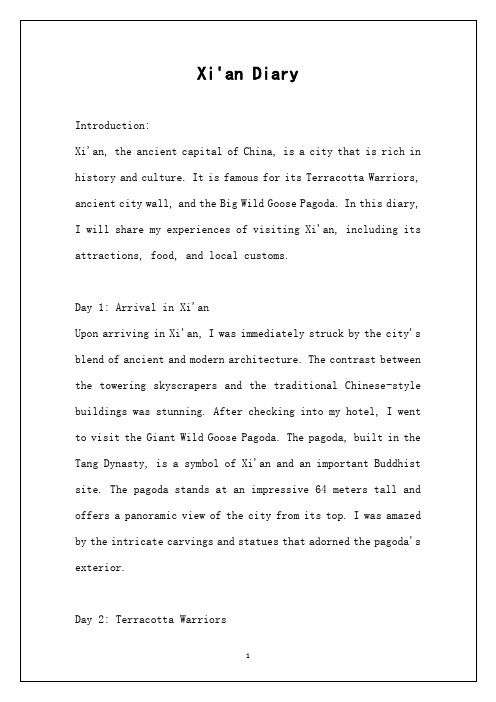
Introduction:
Xi'an, the ancient capital of China, is a city that is rich in history and culture. It is famous for its Terracotta Warriors, ancient city wall, and the Big Wild Goose Pagoda. In this diary, I will share my experiences of visiting Xi'an, including its attractions, food, and local customs.
第四天:离开西安
随着我在西安的时间接近尾声,我反思了我所经历的丰富历史和充满活力的文化。从兵马俑的古迹到回民街的热闹街景,西安给我留下了深刻的印象。我希望有朝一日能再次回到这个令人难忘的城市,进一步探索它的宝藏,深入了解它迷人的过去。
总之,我对西安的访问是一次真正丰富的经历。这座城市的历史遗迹、美味的食物和热情好客的当地人使它成为了一个令人难忘的目的地。我向所有对中国历史和文化感兴趣的人推荐西安,我期待着未来能有机会再次访问。
Day 3: City Wall and Muslim Quarter
On my third day in Xi'an, I rented a bike and cycled arouhich was originally built as a military defense system, now serves as a popular tourist attraction. The views of the city from the top of the wall were breathtaking, and I enjoyed the peaceful atmosphere as I pedaled along the ancient fortifications. In the evening, I visited the Muslim Quarter, a bustling area known for its lively street markets and delicious food. I sampled traditional Xi'an snacks such as roujiamo (Chinese hamburger) and yangrou paomo (crumbled unleavened bread in mutton stew), and I was impressed by the flavors and variety of the local cuisine.
描写西安古城的英语句子
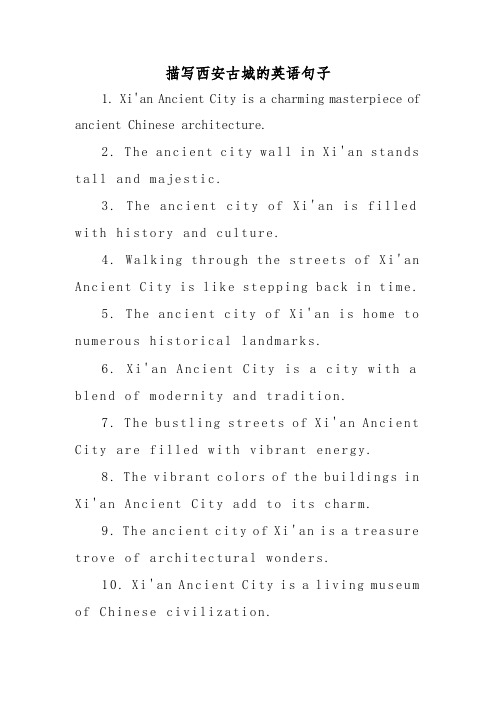
28. The Xi'an Museum in Xi'an Ancient City showcases the city's rich cultural heritage.
17. Xi'an Ancient City is a perfect blend of traditional and modern lifestyles.
18. The ancient city of Xi'an has witnessed the rise and fall of dynasties.
3. The ancient city of Xi'an is filled with history and culture.
4. Walking through the streets ofXi'an Ancient City is like stepping back in time.
5. The ancient city of Xi'an is home to numerous historical landmarks.
25. Xi'an Ancient City is a city where history seamlessly merges with modernity.
26. The Hui Min Jie Food Street in Xi'an Ancient City is a must-visit forfood lovers.
47. Xi'an Ancient City is a city where every corner tells a story.
英语六级翻译每日一练 西安

英语六级翻译每日一练西安西安翻译原文:西安,古称长安,是著名的古都,也是中华文明的发祥地。
它断断续续作为13个王朝的首都达1200多年之久。
西安是中国古代第一个对外开放的城市。
汉唐时期,它是中国政治、经济、文化和对外交流的中心。
西安有很多珍贵的文物和遗址、秦始皇兵马俑,被誉为“世界第八大奇迹”。
西安古城墙是世界上规模最大、保存最完整的古城墙遗址。
灿烂的文化、悠久的历史以及丰富的文物和遗址,使得西安享有“自然史博物馆”的美称。
参考译文:Xi’an, called Chang’an in ancient times, was an ancient capital and the birthplace of Chinese civilization. It served intermittently as the capital of 13 dynasties over 1,200 years. Xi’an was the first city to open its doors to the world in ancient China.In the Han and Tang Dynasties, it was the center of China’s politics, economy, culture and international exchange.There are a large number of treasured cultural relics and sites in Xi’an. TheTerra-cotta Warriors and Horses are honored as“The Eighth Wonder of the World”. The Ancient City Wall of Xi’an is the largest, best preserved ruin of ancient city wall in the world. Owing to its brilliant culture, long history, as well as abundant relics and sites, Xi’an enjoys the laudatory title of “Natural History Museum”.重点词汇:古都:ancient capital发祥地:birthplace/cradle断断续续:intermittently对外交流:international exchange珍贵的文物:treasured cultural relics兵马俑:the Terra-cotta Warriors and Horses 被誉为:be honored as保存最完整:best preserved / best kept古城墙:ancient city wall遗址:ruin美称:laudatory title。
西安英文介绍
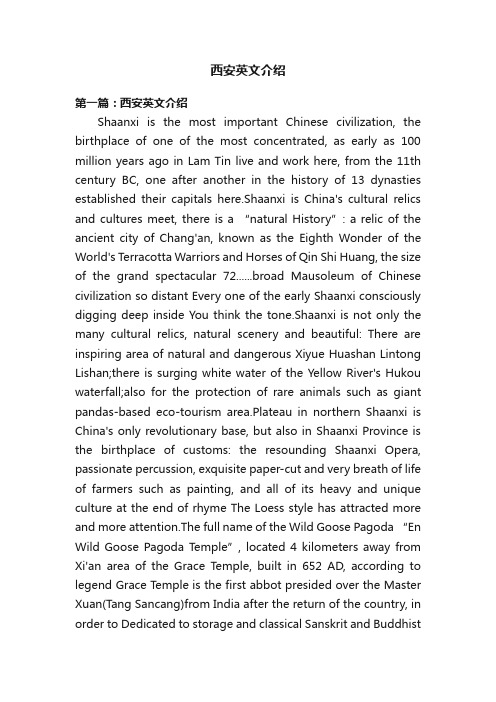
西安英文介绍第一篇:西安英文介绍Shaanxi is the most important Chinese civilization, the birthplace of one of the most concentrated, as early as 100 million years ago in Lam Tin live and work here, from the 11th century BC, one after another in the history of 13 dynasties established their capitals here.Shaanxi is China's cultural relics and cultures meet, there is a “natural History”: a relic of the ancient city of Chang'an, known as the Eighth Wonder of the World's Terracotta Warriors and Horses of Qin Shi Huang, the size of the grand spectacular 72......broad Mausoleum of Chinese civilization so distant Every one of the early Shaanxi consciously digging deep inside You think the tone.Shaanxi is not only the many cultural relics, natural scenery and beautiful: There are inspiring area of natural and dangerous Xiyue Huashan Lintong Lishan;there is surging white water of the Yellow River's Hukou waterfall;also for the protection of rare animals such as giant pandas-based eco-tourism area.Plateau in northern Shaanxi is China's only revolutionary base, but also in Shaanxi Province is the birthplace of customs: the resounding Shaanxi Opera, passionate percussion, exquisite paper-cut and very breath of life of farmers such as painting, and all of its heavy and unique culture at the end of rhyme The Loess style has attracted more and more attention.The full name of the Wild Goose Pagoda “En Wild Goose Pagoda Temple”, located 4 kilometers away from Xi'an area of the Grace Temple, built in 652 AD, according to legend Grace Temple is the first abbot presided over the Master Xuan(Tang Sancang)from India after the return of the country, in order to Dedicated to storage and classical Sanskrit and Buddhistrelics and other objects Duzao personally designed and built.Huaqing Pool is located in Xi'an Lintong district on the north side of Lishan, 30 km east of Xi'an.Huaqing Pool because of the emperor and Yang legend and reputation spread far and wide, in fact, the Huaqing Pool is a long history, legend, in the early Western Zhou Dynasty, Zhou You Wang Jian Li was in the palace;generations of the First Qin Emperor, Emperor also set up here Palace;more large-scale construction of the Tang Dynasty, in particular the emperor Tianbao years to build a more luxurious palace pavilion, and changed its name to the official “China Palace.”Terracotta warriors and horses is the only imperial tombs from the mass grave, located on the eastern side of Qin Shi Huang Mausoleum of about 1 kilometer and a half, was found in 1974, is the most important archaeological discoveries of.One pit was discovered when local farmers digging, drilling after another has found that two pit on the 3rd, one of which pits the largest, covering an area of 14,260 square meters.A total of three pits excavated more than 700 pieces of pottery figurine, by more than 100 tanks, more than 400 horses Ma Tao, more than 100,000 pieces of weapons.Pottery figurine at the height of 1 meter 75-1 m 85, according to dress, look, the style, can be divided into general figurines, warrior figurines, figurines, and other vehicles with disabilities.There are also excavated pit sword, spear, halberd, bronze weapons such as machetes, although buried in the soil in more than two thousand years, the blade is still sharp, sparkling, can be seen as a miracle in the history of metallurgy in the world.Terracotta Warriors and Horses of Qin Shi Huang large-scale, powerful scenes, with high artistic value.Clock Tower is located in Xi'an city of the North and the South East and WestMain Street, four of the interchange.Ming Hongwu 17 years before, the site of the Xi'an Guangji in this corner, Wanli next 10 years to move the site of the Qing Emperor Qianlong had five-year renovation.Bronze bell hanging on the clock tower to time, the clock tower named.Drum T ower in Xi'an is located in North and West Main Street Interchange house, the Clock Tower in the east every other across the square, the Drum Tower Ming Hongwu 13 years, twice rebuilt in the Qing Dynasty.The original one upstairs giant drum, drumming in the evening time, the Drum Tower named.陕西是华夏文明最重要、最集中的发源地之一,早在100万年前就有蓝田人在此生息劳作,从公元前11世纪起,历史上先后有13个朝代在此建都。
Xi'an 西安的英文介绍
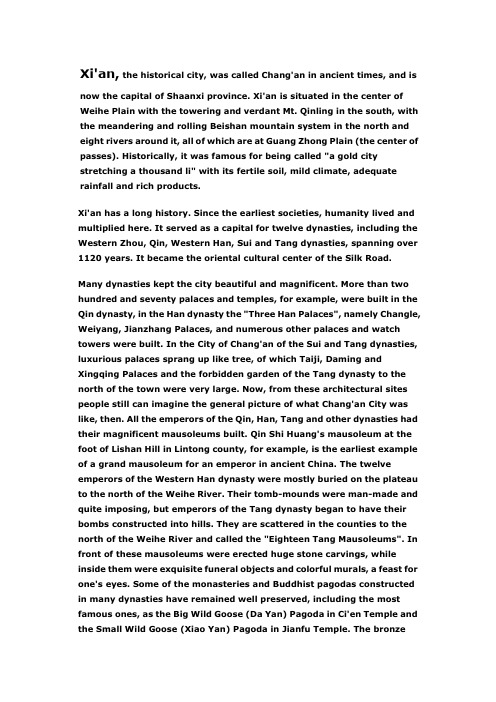
Xi'an, the historical city, was called Chang'an in ancient times, and isnow the capital of Shaanxi province. Xi'an is situated in the center of Weihe Plain with the towering and verdant Mt. Qinling in the south, with the meandering and rolling Beishan mountain system in the north and eight rivers around it, all of which are at Guang Zhong Plain (the center of passes). Historically, it was famous for being called "a gold city stretching a thousand li" with its fertile soil, mild climate, adequate rainfall and rich products.Xi'an has a long history. Since the earliest societies, humanity lived and multiplied here. It served as a capital for twelve dynasties, including the Western Zhou, Qin, Western Han, Sui and Tang dynasties, spanning over 1120 years. It became the oriental cultural center of the Silk Road.Many dynasties kept the city beautiful and magnificent. More than two hundred and seventy palaces and temples, for example, were built in the Qin dynasty, in the Han dynasty the "Three Han Palaces", namely Changle, Weiyang, Jianzhang Palaces, and numerous other palaces and watch towers were built. In the City of Chang'an of the Sui and Tang dynasties, luxurious palaces sprang up like tree, of which Taiji, Daming and Xingqing Palaces and the forbidden garden of the Tang dynasty to the north of the town were very large. Now, from these architectural sites people still can imagine the general picture of what Chang'an City was like, then. All the emperors of the Qin, Han, Tang and other dynasties had their magnificent mausoleums built. Qin Shi Huang's mausoleum at the foot of Lishan Hill in Lintong county, for example, is the earliest example of a grand mausoleum for an emperor in ancient China. The twelve emperors of the Western Han dynasty were mostly buried on the plateau to the north of the Weihe River. Their tomb-mounds were man-made and quite imposing, but emperors of the Tang dynasty began to have their bombs constructed into hills. They are scattered in the counties to the north of the Weihe River and called the "Eighteen Tang Mausoleums". In front of these mausoleums were erected huge stone carvings, while inside them were exquisite funeral objects and colorful murals, a feast for one's eyes. Some of the monasteries and Buddhist pagodas constructed in many dynasties have remained well preserved, including the most famous ones, as the Big Wild Goose (Da Yan) Pagoda in Ci'en Temple and the Small Wild Goose (Xiao Yan) Pagoda in Jianfu Temple. The bronzewares of ancient China are an important example of the splendid culture that reflect this slave society. Feng and Hao in the Xi'an area, which were the capitals of the Western Zhou dynasty, have been acclaimed as "the Home of the Bronze wares", as a wealth of bronze items unearthed from there, over the years. It was quite popular to put up stone tablets in front of tombs to record the merits and achievements of the departed, in many dynasties, and a great deal of stone tablets and calligraphy data remain to this day. So Xi'an is also famous for being "the Home of Calligraphy".Xi'an is the largest commercial and trade-hub, as well as the largest material distribution center in the Mid-Western Region of northern China. As shown in a report in 1998, there are more than 100,000 commercial service networks, 435 consumption markets, and 485 various types of wholesale markets, and nearly 1,000 wholesale agencies.Xi'an is powerful in terms of its scientific and technological strength, the comprehensive strength ranks second in China. Xi'an boasts 727 scientific research institutions, technical personnel constitute 26.4% of the total working staff in Xi'an. The proportion of technical personnel in Xi'an is the highest in China. There are 38 institutions of higher learning.A batch of advanced experimental bases and testing centers have the capability of assimilate, digest and transfer state-level and world-level technologies. The applied technologies in the fields of aeronautics, aerospace, mechanics, electronics, meter and instrument, optics, textile and power equipment are in the leading position in China. Xi'an is one of the important scientific research and higher education bases in China.Terra-cotta Warriors and HorsesIn 221 B.C., Emperor Qin Shi Huang of the Qin dynasty established the first centralized feudal dynasty in China. After his death, he was buried at the north foot of Lishan Hill in the east of Lintong county. The tomb is a rammed-soil mound, 47m. high and its base is 485m.× 515m. In 1974, three large pits of terra-cotta figures were found 1.5 km. east of the mausoleum. Among the three, the largest one is pit No.1, covering 14,260 sq.m.. The pit is divided into eleven corridors in which arrayed 38 columns of life-sized clay warriors, horses and chariots.Over 6,000 clay warriors could be assumedly unearthed from the pit if it would be completely excavated. This would be really an artistic reappearance of hundreds of Qin Shi Huang's warriors. With its artistic momentum, it could be acclaimed a piece of great masterwork. The figures, life-likely shaped and colorfully painted, are of high artistic value. Now, a big arch-roofed exhibition hall is set up over Pit No.1 where the restored terra-cotta warriors and horses are on display.Big Wild Goose PagodaThe pagoda was originally situated within the premises of the Temple of Motherly Kindness in the Jinchang Block in the Chang'an city of the Tang Dynasty. The Temple was built in 648 A.D. (twenty-second year of Zhenguan of the Tang) by the then Prince Li Zhi, who later became Emperor Gaozong, to honor his mother, Empress Wende. The Pagoda itself was built in 652 (third year of Yonghui of the Tang Emperor Gaozong). A square pyramid of blue brick, it is 64 meters high, with seven stories. It is simple in shape, and of good and lofty proportion. Preserved on the four stone doors in the base of the pagoda are exquisite engravings of the Tang. Two steles with "the preface to the Sacred Religion" written by the famous Tang calligrapher Chu Suiliang are set into the walls on the either side of the south door of the pagoda. Because of their distinctive and elegant inscriptions, the steles are valuable data for the art of calligraphy.City WallThe Xi'an City Wall is the best preserved, oldest and largest ancient city defense system in China. It is also one of the most important landmarks of the Xi'an city. The original foundation of the Xi'an City Wall was based on the ruins of the Imperial City Wall of Chang'an City--the capital of the Tang Dynasty. In 904 A.D. when the capital of the Tang Dynasty was moved eastward, the Governor-general Han Jian had the city renovated and turned it into an army garrison and named it "New City".Since then the city was used continuously by Song and Yuan Dynasties, and its features kept unchanged. The Ming Dynasty was set up in 1368 and the Ming army entered the city in 1369. Afterward the city was renamed as "the Prefecture of Xi'an".In 1370 the First Ming Emperor Zhu Yuan Zhang conferred the title of "King of Qin" on his second son Zhu Shuang and sent him to rule in Shaanxi. The King's official residence was chosen and built in Xi'an City. According to the Ming Dynasty's stipulation, when the title of King was conferred upon the Emperor's son, his costume, Carriage, flag andresidence had to be one grade lower than the emperors'. The old city was dilapidated and its size was small, so it was not up to the standard.In 1370, the government began to extend the size of the Xi'an City, and build the huge project of the residence for the Ding of Qin. It was completed within eight years. When the city began to take shape, it was divided into inner city and outer city. The outer city is 13.7 km. in circumference and it occupies an area of 11.5 square km. The structure of the City Wall was earth-rammed.Around the City Wall there are jutting ramparts, sentry towers, corner towers, gate towers, battlements and a series of city defensive fortifications which were scientifically and compactly laid out with very strong defense capability. The inner city was the residence for the King of Qin. It was built at the high terrain in the north-eastern part of the city, from where the whole city could be well under control by its advantage of geographical position. The residence was enclosed by two successive walls and a protective moat. The principal part of the architectural complex was built according the traditional pattern of "Palace in the front and bedchamber at the back". The important palaces and temples were longitudinally arranged in a round pivot order. They looked magnificent and splendid.During the 200 years reign of the Ming Dynasty, the inner city continuously served as the military and political center of Shaanxi, where the successive 14 Kings of Qing acted on the order of the Emperor to rule Shaanxi. The Xi'an City Wall has a history of over 600 years since it was built in the early Ming Dynasty. Nowadays, this old historical relic is not only an important material object for the study of ancient military science but also a sightseeing and entertainment resort for the visitors.。
西安简介英语带翻译
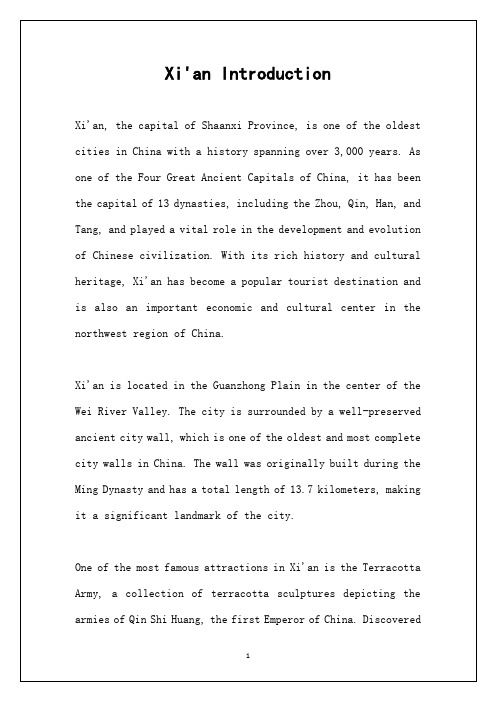
Xi'an is located in the Guanzhong Plain in the center of the Wei River Valley. The city is surrounded by a well-preserved ancient city wall, which is one of the oldest and most complete city walls in China. The wall was originally built during the Ming Dynasty and has a total length of 13.7 kilometers, making it a significant landmark of the city.
In recent years, Xi'an has also been actively promoting the development of its high-tech industry, with a focus on information technology, aerospace, and new energy. As a result, the city has attracted a large number of talented professionals and entrepreneurs, as well as significant investment from both domestic and international companies.
西安的英语作文初中带翻译
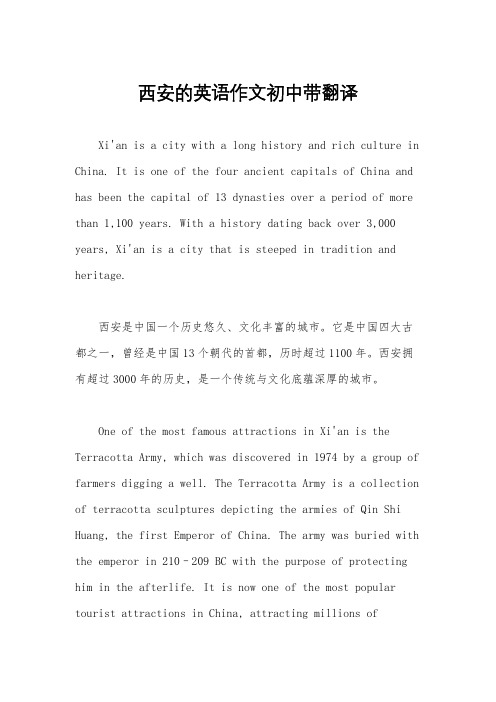
西安的英语作文初中带翻译Xi'an is a city with a long history and rich culture in China. It is one of the four ancient capitals of China and has been the capital of 13 dynasties over a period of more than 1,100 years. With a history dating back over 3,000 years, Xi'an is a city that is steeped in tradition and heritage.西安是中国一个历史悠久、文化丰富的城市。
它是中国四大古都之一,曾经是中国13个朝代的首都,历时超过1100年。
西安拥有超过3000年的历史,是一个传统与文化底蕴深厚的城市。
One of the most famous attractions in Xi'an is the Terracotta Army, which was discovered in 1974 by a group of farmers digging a well. The Terracotta Army is a collection of terracotta sculptures depicting the armies of Qin Shi Huang, the first Emperor of China. The army was buried with the emperor in 210–209 BC with the purpose of protecting him in the afterlife. It is now one of the most popular tourist attractions in China, attracting millions ofvisitors from around the world every year.西安最著名的景点之一是兵马俑,1974年被一群农民在挖井时发现。
用英文介绍西安

Xian, a City with a Rich History andVibrant CultureXian, located in the heart of China, is a city thatboasts a rich history and vibrant culture. As one of theoldest cities in the world, Xian has been an important center of trade, politics, and culture for thousands of years. Thecity is famous for its ancient landmarks, such as the Terracotta Army, the Great Mosque, and the City Wall, whichare all mustsee attractions for visitors.The Terracotta Army, located about 30 miles east of Xian, is one of the most famous archaeological sites in the world. Discovered in 1974, the army consists of more than 8,000 lifesize terracotta soldiers, horses, and chariots, all arranged in battle formation. The site is a testament to the power and wealth of the first emperor of China, Qin Shi Huang, who ordered the creation of the army to protect him in the afterlife.The Great Mosque, located in the Muslim quarter of Xian,is one of the oldest mosques in China. Built in the 7th century, the mosque is a blend of Chinese and Islamic architecture, with traditional Chinese elements such as wooden arches and upturned eaves, as well as Islamic featuressuch as minarets and domes. The mosque is still in use today and is a popular destination for both tourists and worshippers.The City Wall, which encircles the old city of Xian, is one of the most impressive ancient structures in China. Built in the 14th century, the wall is 12 meters high and 14 kilometers long, and it is one of the bestpreserved city walls in the world. Visitors can walk or bike along the top of the wall, enjoying panoramic views of the city and its surroundings.In addition to its historical landmarks, Xian is also known for its vibrant culture. The city is famous for its delicious food, such as Xi'an noodles and roujiamo (a type of hamburger made with bread and minced meat). The city is also home to a number of cultural festivals, such as the Lantern Festival, which is celebrated every year on the 15th day of the first lunar month.In conclusion, Xian is a city that offers a unique blend of history and culture. Whether you are interested in ancient history, delicious food, or vibrant culture, Xian has something to offer everyone.Xian, a City with a Rich History and Vibrant CultureXian, located in the heart of China, is a city that boasts a rich history and vibrant culture. As one of theoldest cities in the world, Xian has been an important center of trade, politics, and culture for thousands of years. Thecity is famous for its ancient landmarks, such as the Terracotta Army, the Great Mosque, and the City Wall, whichare all mustsee attractions for visitors.The Terracotta Army, located about 30 miles east of Xian, is one of the most famous archaeological sites in the world. Discovered in 1974, the army consists of more than 8,000 lifesize terracotta soldiers, horses, and chariots, all arranged in battle formation. The site is a testament to the power and wealth of the first emperor of China, Qin Shi Huang, who ordered the creation of the army to protect him in the afterlife.The Great Mosque, located in the Muslim quarter of Xian,is one of the oldest mosques in China. Built in the 7th century, the mosque is a blend of Chinese and Islamic architecture, with traditional Chinese elements such as wooden arches and upturned eaves, as well as Islamic features such as minarets and domes. The mosque is still in use today and is a popular destination for both tourists and worshippers.The City Wall, which encircles the old city of Xian, is one of the most impressive ancient structures in China. Built in the 14th century, the wall is 12 meters high and 14kilometers long, and it is one of the bestpreserved city walls in the world. Visitors can walk or bike along the top of the wall, enjoying panoramic views of the city and its surroundings.In addition to its historical landmarks, Xian is also known for its vibrant culture. The city is famous for its delicious food, such as Xi'an noodles and roujiamo (a type of hamburger made with bread and minced meat). The city is also home to a number of cultural festivals, such as the Lantern Festival, which is celebrated every year on the 15th day of the first lunar month.Furthermore, Xian is a city that is rich in artistic and cultural heritage. The city is home to a number of museums and galleries, such as the Shaanxi History Museum and the Xian Art Museum, which showcase the region's rich history and artistic achievements. The city is also known for its traditional arts and crafts, such as paper cutting, embroidery, and pottery.In conclusion, Xian is a city that offers a unique blend of history and culture. Whether you are interested in ancient history, delicious food, or vibrant culture, Xian has something to offer everyone. The city's rich history and vibrant culture make it a mustvisit destination for anyone traveling to China.Xian, a City with a Rich History and Vibrant CultureXian, located in the heart of China, is a city thatboasts a rich history and vibrant culture. As one of theoldest cities in the world, Xian has been an important center of trade, politics, and culture for thousands of years. Thecity is famous for its ancient landmarks, such as the Terracotta Army, the Great Mosque, and the City Wall, whichare all mustsee attractions for visitors.The Terracotta Army, located about 30 miles east of Xian, is one of the most famous archaeological sites in the world. Discovered in 1974, the army consists of more than 8,000 lifesize terracotta soldiers, horses, and chariots, all arranged in battle formation. The site is a testament to the power and wealth of the first emperor of China, Qin Shi Huang, who ordered the creation of the army to protect him in the afterlife.The Great Mosque, located in the Muslim quarter of Xian,is one of the oldest mosques in China. Built in the 7th century, the mosque is a blend of Chinese and Islamic architecture, with traditional Chinese elements such as wooden arches and upturned eaves, as well as Islamic features such as minarets and domes. The mosque is still in use today and is a popular destination for both tourists and worshippers.The City Wall, which encircles the old city of Xian, is one of the most impressive ancient structures in China. Built in the 14th century, the wall is 12 meters high and 14 kilometers long, and it is one of the bestpreserved city walls in the world. Visitors can walk or bike along the top of the wall, enjoying panoramic views of the city and its surroundings.In addition to its historical landmarks, Xian is also known for its vibrant culture. The city is famous for its delicious food, such as Xi'an noodles and roujiamo (a type of hamburger made with bread and minced meat). The city is also home to a number of cultural festivals, such as the Lantern Festival, which is celebrated every year on the 15th day of the first lunar month.Furthermore, Xian is a city that is rich in artistic and cultural heritage. The city is home to a number of museums and galleries, such as the Shaanxi History Museum and the Xian Art Museum, which showcase the region's rich history and artistic achievements. The city is also known for its traditional arts and crafts, such as paper cutting, embroidery, and pottery.Moreover, Xian is a city that is full of life and energy. The city's streets are lined with bustling markets, where visitors can sample local cuisine, purchase souvenirs, andexperience the local culture. The city's nightlife is also vibrant, with a variety of bars, clubs, and restaurants to choose from.In conclusion, Xian is a city that offers a unique blend of history and culture. Whether you are interested in ancient history, delicious food, or vibrant culture, Xian has something to offer everyone. The city's rich history and vibrant culture make it a mustvisit destination for anyone traveling to China.。
介绍西安的英语作文带翻译

介绍西安的英语作文带翻译Some of the most well-known sites in Xi'an are:The city is surrounded by a well-preserved City wall of Xi'an which was re-constructed in the 14th century during the early Ming Dynasty and was based on the inner imperial palace of Tang Dynasty.以下是小编为大家整理分享的介绍西安的英语作文带翻译,欢迎阅读参考。
介绍西安的英语作文带翻译1Xi'an (Chinese:西安),is the capital of the Shanxi province in the People's Republic of China .As one of the oldest cities in Chinese history,Xi'an is one of the Four Great Ancient Capitals of China because it has been the capital of some of the most important dynasties in Chinese history,including the Zhou,Qin,Han,the Sui,and Tang 'an is the eastern end of the Silk Road .The city has more than 3,100 years of history,and was known as Chang'an (traditional Chinese:长安).Long holidays are usual during Spring Festival,Labor Holiday (1-7 May),and National Holiday (1-7 October).The number of travellers is often greater during Summer (May-August),although the most pleasantseason for visiting Xi'an is Autumn.介绍西安的英语作文带翻译2Some of the most well-known sites in Xi'an are:The city is surrounded by a well-preserved City wall of Xi'an which was re-constructed in the 14th century during the early Ming Dynasty and was based on the inner imperial palace of Tang Mausoleum of Qin Shi Huang and his Terracotta Army are located 40 km to the east of the city centre,in the city's Bell Tower and Drum Tower,both are located at the city's central city's Muslim quarter,which is home to the Great Mosque of Xi' Giant Wild Goose Pagoda and Small Wild Goose Pagoda are both spectacular towers and both are well over 1,000 years old and have survived great former is next to a large square with the largest fountain in Asia which projects water high into the air,rising and falling in time to music during one of the daily performances (usually at noon and soon after sunset).They protected Buddhist writings in the Stele Forest is famous for its numerous historic inscriptions and stoneworksThe Famen Temple and its towering pagoda located on the city's outskirtXi Ming TempleWolong Temple at KaitonglaneXingjiao Temple at Shaolin Yuan (where Xuanzang's Tomb lies)Jianfu TempleBlue Dragon TempleWangji TempleThe Banpo Neolithic village is located on the outskirt of the city properThe Qianling Mausoleum,one of the many Tang Dynasty era tombs located in Xi'anThe Shaanxi History Museum has a large collection of artifacts both modern and Hua is one of the most visited and steepest mountains in the countryMount Zhongnan (终南山)Mount TaibaiMount LiHuaqing Hot Springs (华清池),at the foot of ,have a history of 6,000 years,the adjacent Huaqing Palace has a history of 3,000 among the Hundred Famous Gardens in China,it also has the status as a National Cultural Relic Protection Unit and a National Key Scenic Area.。
西安春游的英文作文带翻译

西安春游的英文作文带翻译Title: A Colorful Spring Outing in Xi'an。
1.西安,这座千年古都,每个春天都仿佛在唤醒沉睡的历史。
The ancient city of Xi'an, with its rich history, comes alive in every spring, breathing new life into its ancient stories.2.漫步在秦岭的绿意中,徒步穿越骊山的蜿蜒小径,感受那份宁静与生机。
Wandering through the lush greenery of the Qinling Mountains or tracing the winding paths of骊山,you'll find tranquility and vitality in every step.3.不必远行,大雁塔下的樱花盛开,犹如粉色的梦幻仙境。
No need to venture far, the blooming cherry blossoms at the Big Wild Goose Pagoda create a fairy tale landscape, a pink paradise right in the heart of the city.4.夜幕降临,回民街的灯火璀璨,品尝当地美食,品味西安的地道风味。
As the night falls, the bustling Muslim Quarterwith its vibrant lights offers a taste of Xi'an's local delicacies, immersing you in the city's culinary essence.5.春风吹过,西安的城墙在阳光下熠熠生辉,历史与现代在此交融。
西安英文介绍简短

西安英语介绍1Xi'an, a city brimming with history and culture, is a captivating destination that leaves an indelible mark on the hearts of all who visit. The renowned Terracotta Army is one of the most remarkable attractions. Dating back thousands of years, these life-sized statues were created to accompany the emperor in the afterlife. Standing in awe before the vast array of soldiers and horses, one can't help but marvel at the craftsmanship and the historical significance they represent.The cuisine of Xi'an is equally enchanting. The Roujiamo, a succulent meat-filled bun, is a local favorite. The tender meat, rich in flavor, combined with the freshly baked bun creates a taste that is both comforting and addictive. Another must-try is the Liangpi, a refreshing cold dish made of thin noodles. The combination of the spicy sauce and the cool texture makes it a hit among both locals and tourists.Xi'an's ancient city walls are also a sight to behold. They stand as a silent witness to the passage of time, offering a peaceful escape from the hustle and bustle of modern life. As one walks along the walls, they can soak in the panoramic views of the city and imagine the stories that have unfolded within its boundaries.In conclusion, Xi'an is not just a city; it is a living museum thatcombines the past and the present. It welcomes visitors with open arms, inviting them to explore and fall in love with its unique charm.2Xi'an, a city steeped in history and culture, is a gem in the heart of China. The ancient city wall of Xi'an is a remarkable testament to its glorious past. It stretches for kilometers, standing as a silent guardian of the city's heritage. Built centuries ago, it not only served as a defense but also holds within it stories of battles and peace.The traditional architectural style of Xi'an, such as the siheyuan, is another aspect that showcases its unique charm. These courtyard houses, with their symmetrical layout and exquisite detailing, reflect the harmony and balance in Chinese culture. The wooden structures and carved decorations tell tales of craftsmanship passed down through generations.Xi'an's streets are lined with ancient buildings that seem to whisper the wisdom of the ages. The food stalls offering mouthwatering delicacies add to the city's allure. The local people, with their warm smiles and friendly nature, make visitors feel at home. Xi'an is not just a city; it is a living museum, inviting all to explore and embrace its rich history and vibrant present.3Xi'an, a city brimming with history and charm, is a place thatcaptivates the hearts and minds of all who visit. The Giant Wild Goose Pagoda stands as a majestic symbol of this ancient city. Legend has it that it was built to store the precious Buddhist scriptures brought back by the famous monk Xuanzang. This pagoda not only showcases exquisite architectural craftsmanship but also holds within it tales of devotion and wisdom.The folk culture of Xi'an, especially the Qinqiang Opera, is another aspect that adds to its allure. The performances of Qinqiang Opera are a vivid display of local traditions. The actors' powerful voices, elaborate costumes, and passionate expressions convey the depth and intensity of the stories. The influence of Qinqiang Opera spreads far and wide, touching the souls of both the local people and those from afar.Xi'an's cuisine is also a highlight. The rich and diverse flavors of the local dishes make one's taste buds dance with joy. The streets are filled with the aroma of mouthwatering delicacies.In conclusion, Xi'an is a city that combines the past and the present, offering a unique and unforgettable experience to all who have the fortune to explore its wonders.4Xi'an, a city steeped in history and brimming with modern vitality, holds an eminent position not only in China but also on the global stage. In ancient times, it served as the political center of several dynasties,witnessing the rise and fall of empires. The magnificent palaces and grand architectures were testament to its past glory.Fast forward to the present, Xi'an has emerged as a significant hub in the fields of technology and education. Renowned universities and research institutions are located here, nurturing a vast number of talents who are driving innovation and progress. The city's technological parks are home to cutting-edge research and development, making significant contributions to the nation's technological advancement.Xi'an seamlessly blends its rich historical heritage with modern achievements. The ancient city walls stand as a silent guardian of the past, while the bustling high-tech zones represent the hope and promise of the future. It is a place where history and modernity coexist in harmony, making it a truly unique and remarkable city.5Xi'an, a city brimming with history and culture, offers a captivating glimpse into the diverse tapestry of human civilization. The city is home to numerous religious places, among which the mosques stand out. These mosques witness various religious activities that reflect the harmonious blend of different beliefs. People of different faiths come together, sharing mutual respect and understanding, creating a peaceful and inclusive atmosphere.Xi'an is also renowned for its splendid folk arts, such as paper-cutting.The craftsmanship involved in creating these delicate paper-cuts is truly remarkable. Each intricate design conveys not only the artist's skill but also the rich cultural heritage and aesthetic values. The patterns often draw inspiration from local legends, customs, and nature, presenting a vivid picture of the people's lives and their deep connection with the land.The cultural diversity of Xi'an is not just something to be observed but experienced. It is a living testament to the power of coexistence and mutual appreciation among different traditions. This city serves as a reminder that through embracing and celebrating our differences, we can create a more vibrant and harmonious world.。
英文介绍_英文介绍西安

西安英文简介Xi'an, the eternal(永恒的)city, records the great changes of the Chinese nation just like a living history book,Called Chang' an in ancient times,Xian is one of the birthplaces of the ancient civilization in the Yellow River Basin area of the country. During Xi'an's 3,100 year development, 13 dynasties such as Western Zhou (11th century BC - 771 BC), Qin (221 BC - 206 BC), Western Han (206 BC - 24 AD) and Tang (618 - 907) placed their capitals here. So far, Xi'an enjoys equal fame with Athens(雅典), Cairo(开罗), and Rome as one of the four major ancient civilization capitals. Xi'an is the capital of Shaanxi province, located in the southern part of the Guanzhong Plain(关中平原). With the Qinling Mountains to the south and the Weihe River to the north, it is in a favorable geographical location surrounded by water and hills. It has a semi-moist monsoon climate and there is a clear distinction between the four seasons. Except the colder winter, any season is relatively suitable for traveling.The cultural and historical significance of the area, as well as the abundant relics and sites(遗迹),help Xi'an enjoy the laudatory title(美称) of 'Natural History Museum'. The Museum of Terra Cotta Warriors and Horses(兵马俑) is praised as 'the eighth major miracle of the world', Mausoleum (陵墓)of Emperor Qin Shi Huang is listed on the World Heritage List(世界遗产名录) , and the City Wall of the Ming Dynasty (1368 - 1644) is the largest and most intact(完整的) Ming Dynasty castle in the world. Around Xi'an, the Famen Temple enjoys the reputation of being the 'forefather of pagodas and temples in Central Shaanxi,' because it holds the finger bones of Sakyamuni -- the founder of Buddhism. The natural landscape (自然风光)around Xi'an is also marvelous(极妙的,不可思议的). Mt.Huashan ,one of the five best-known mountains in China, is famous for its breath-taking (令人吃惊的)cliffs(悬崖) and its unique characteristics.Traditional downtown Xi'an refers to the area encircled (环绕)by the city wall, this has now been expanded to encompass(围绕) the area within the second ring road (Er' huan Lu). The Bell Tower is the geographical center of Xi'an and the four main streets are respectively (分别地)Dong Dajie, Xi Dajie, Nan Dajie and Bei Dajie which are also the main commercial streets. Xiao Zhai, the busiest commercial area is in the southern part of the city and is popular with both youths and students since many universities are located here. ShuyuanMen and the still under construction Luoma Shi are must-visit pedestrian (步行的)streets in the city. Xi'an is also famous for its quantity of colleges throughout China. The old campuses of many colleges and universities are massed in the southern suburb of Xi'an, but most have established new campuses in far southern suburb - Chang'an District due to the lack of space within the city.Praised as 'the capital of tabl e d elicacies', Xi'an has been rich in the d elicious Shaanxi snack(小吃), d elicate Guangd ong Cuisine, various kinds of fashionabl e foreign d elicacies, and popular Sichuan Cuisine such as the hot pot. Among all the d elicacies, the most famous and popular one is the Muslim Snack Street. Xi'an peopl e love hot steamed mutton(还有梆梆面、柿面糊塌、凉皮、炒粉鱼、锅盔、千层油酥饼等特色小吃),cool noodl e, persimmon batter d own, Guokui and other special snacks pastries .Xi'an is the most important city in northwest China, and so there are a lot of shopping outlets for locals and tourists alike. There are many big shopping centers, department stores and supermarkets in and around Xi'an city - the biggest and most comprehensive being Kai Yuan Shopping Mall and Century Ginwa Shopping Mall.The night life in Xi'an has a unique glamour(魅力). Traditional ways include enjoying the night scenery around the Bell Tower, taking part in a Tang Dynasty Dinner Show, strolling on the ancient Big Wild Goose Pagoda Square and watching the music fountain performance. More modern and fashionable ways include singing in the KTV, hanging out in a bar, or dancing in a Disco. All in all, any experience in this ancient city will bring you fun and possibly a little surprise!。
西安英语介绍
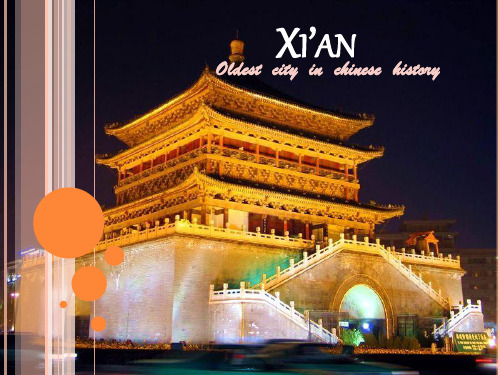
Oldest city in chinese history
The Xi’an City Wall西安城墙
Xian is the capital of Shaanxi province, located in the southern part of the Guanzhong Plain(关 中平原地区) . Xi’an is recognized as one of the most important cities in China, both historically and currently. Xi’an, called
中式汉堡——肉夹馍
葫 芦 头
牛羊肉泡馍
肉丸胡辣汤
秦镇米皮—陕西凉皮“四大花旦”之一
If anyone want to go to Xi'an, I will be very enthusiastic to do your tour
guide!
THANKБайду номын сангаасYOU!
Bell tower
The Bell Tower, is a stately traditional building, that marks the geographical center of the ancient capital. From this important landmark extend East, South, West and North Streets, connecting the Tower to the East, South, West and North Gates of the City Wall of the Ming Dynasty.
Wild Goose Peak (South Peak, 2160m)
关于西安的英文翻译
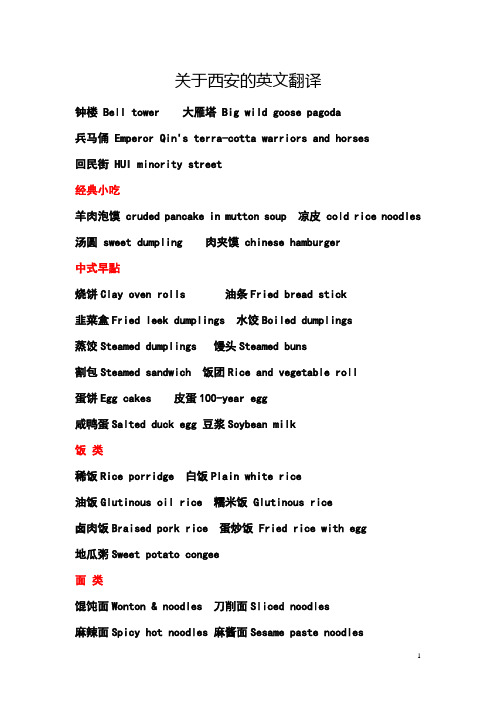
关于西安的英文翻译钟楼 Bell tower 大雁塔 Big wild goose pagoda兵马俑 Emperor Qin's terra-cotta warriors and horses回民街 HUI minority street经典小吃羊肉泡馍 cruded pancake in mutton soup 凉皮 cold rice noodles 汤圆 sweet dumpling 肉夹馍 chinese hamburger中式早點烧饼Clay oven rolls 油条Fried bread stick韭菜盒Fried leek dumplings 水饺Boiled dumplings蒸饺Steamed dumplings 馒头Steamed buns割包Steamed sandwich 饭团Rice and vegetable roll蛋饼Egg cakes 皮蛋100-year egg咸鸭蛋Salted duck egg 豆浆Soybean milk饭类稀饭Rice porridge 白饭Plain white rice油饭Glutinous oil rice 糯米饭 Glutinous rice卤肉饭Braised pork rice 蛋炒饭 Fried rice with egg地瓜粥Sweet potato congee面类馄饨面Wonton & noodles 刀削面Sliced noodles麻辣面Spicy hot noodles 麻酱面Sesame paste noodles鴨肉面Duck with noodles 鱔魚面Eel noodles乌龙面 Seafood noodles榨菜肉丝面Pork , pickled mustard green noodles牡蛎细面 Oyster thin noodles板条Flat noodles 米粉Rice noodles炒米粉Fried rice noodles冬粉Green bean noodle汤类鱼丸汤Fish ball soup 貢丸汤Meat ball soup蛋花汤Egg & vegetable soup 蛤蜊汤Clams soup牡蛎汤Oyster soup 紫菜汤Seaweed soup酸辣汤Sweet & sour soup 馄饨汤Wonton soup猪肠汤Pork intestine soup甜点爱玉Vegetarian gelatin 糖葫芦Tomatoes on sticks长寿桃Longevity Peaches 芝麻球Glutinous rice sesame balls麻花Hemp flowers 双胞胎Horse hooves冰类绵绵冰Mein mein ice麦角冰 Oatmeal ice地瓜冰Sweet potato ice 紅豆牛奶冰Red bean with milk ice八宝冰Eight treasures ice豆花Tofu pudding果汁甘蔗汁Sugar cane juice 酸梅汁Plum juice杨桃汁Star fruit juice 青草茶Herb juice点心牡蛎煎Oyster omelet 臭豆腐Stinky tofu (Smelly tofu)油豆腐Oily bean curd 麻辣豆腐Spicy hot bean curd虾片Prawn cracker 虾球Shrimp balls春卷Spring rolls 蛋卷Chicken rolls碗糕Salty rice pudding 筒仔米糕Rice tube pudding红豆糕Red bean cake 绿豆糕Bean paste cake糯米糕Glutinous rice cakes 萝卜糕Fried white radish patty 芋头糕Taro cake 肉圆Taiwanese Meatballs水晶饺Pyramid dumplings 肉丸Rice-meat dumplings豆干Dried tofu其他当归鸭Angelica duck 槟榔Betel nut 火锅Hot pot肉羹汤Pork thick soup 鱿鱼汤Squid soup 花枝羹Squid thick soup。
西安英文介绍

Shanxi is the most important Chinese civilization,the provincial capital city, Xi’an is one of the birthplaces of the ancient civilization in the Yellow River Basin area of the country.During Xi’an's 3,100 year development, 13 dynasties such as Western Zhou , Qin , Western Han and Tang placed their capitals here. So far, Xi’an enjoys equal fame with Athens雅典, Cairo开罗, and Rome罗马as one of the four major ancient civilization capitals.So,Xi’an, as the capital of thirteen dynasties,records the great changes of the Chinese nation just like a living history book.In the Qin dynasty,the first emperor of china,qin shihuang established the capital in xi’an in 221BC.and he started the work on the Efang palace,which is extremely luxurious.however ,the Efang palace didn’t exist for too long.King of Western Chu head his army attacked the Xi’an and burnt the palace down.and this poem is describe this,any one who can guess which poem it is in Chinese.In the Han dynasty,dates back to the 2nd century B.C.the han dynasty ,when Zhang Qian went on a business trip to the western countries following this trade thorough fare linking Asia and Europe. China’s silk reached the West along this road,European scholars came to call it the “Silk Road”.In Tang dynastyIn ancient times Xi’an was Called Chang'an , which means the national lasting stability and peace.It truly witness the booming of the ancient china but also the battle and killing .The Incident at Xuanwu Gate (玄武门之变)Li Jiancheng,Li Shimin,Li yuanji were three sons of Gaozu of Tang (the founding emperor of the Chinese dynasty Tang Dynasty).Li Jiancheng was the Crown Prince,Li Shimin was the Prince of Qin,Li Shimin was in an intense rivalry with his older brother and fearing that Li Jiancheng was about to kill him, so he set an ambush at Xuanwu Gate, the gate leading to Emperor Gaozu's palace, and killed Li Jiancheng . He then sent forces into Emperor Gaozu's palace. Emperor Gaozu, under intimidation, created him crown prince, and two months later passed the throne to him (as Emperor Taizong).In modern history ,Xi’an is also a economic and cultural centre of china ,many word-shaking events happened here ,for example The Xi'an Incident .The history of Xi’an is the miniature of china ,too much events happened in this place.if you want to deepen the knowledge of china,you had better begin from its history;if you want to deepen the knowledge of chinese history,you had better begin from Xi’an。
关于西安最全的英文翻译
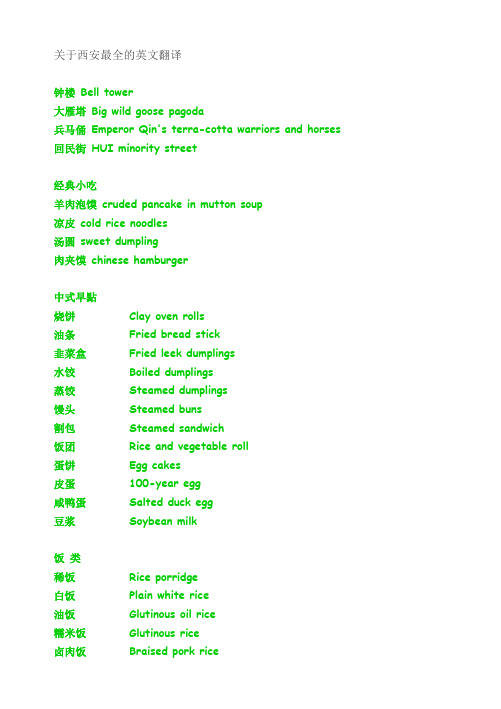
关于西安最全的英文翻译钟楼 Bell tower大雁塔 Big wild goose pagoda兵马俑 Emperor Qin's terra-cotta warriors and horses 回民街 HUI minority street经典小吃羊肉泡馍 cruded pancake in mutton soup凉皮 cold rice noodles汤圆 sweet dumpling肉夹馍 chinese hamburger中式早點烧饼Clay oven rolls油条Fried bread stick韭菜盒Fried leek dumplings水饺Boiled dumplings蒸饺Steamed dumplings馒头Steamed buns割包Steamed sandwich饭团Rice and vegetable roll蛋饼Egg cakes皮蛋100-year egg咸鸭蛋Salted duck egg豆浆Soybean milk饭类稀饭Rice porridge白饭Plain white rice油饭Glutinous oil rice糯米饭Glutinous rice卤肉饭Braised pork rice蛋炒饭Fried rice with egg地瓜粥Sweet potato congee面类馄饨面Wonton & noodles刀削面Sliced noodles麻辣面Spicy hot noodles麻酱面Sesame paste noodles鴨肉面Duck with noodles鱔魚面Eel noodles乌龙面Seafood noodles榨菜肉丝面Pork , pickled mustard green noodles 牡蛎细面Oyster thin noodles板条Flat noodles米粉Rice noodles炒米粉Fried rice noodles冬粉Green bean noodle汤类鱼丸汤Fish ball soup貢丸汤Meat ball soup蛋花汤Egg & vegetable soup蛤蜊汤Clams soup牡蛎汤Oyster soup紫菜汤Seaweed soup酸辣汤Sweet & sour soup馄饨汤Wonton soup猪肠汤Pork intestine soup 甜点爱玉Vegetarian gelatin糖葫芦Tomatoes on sticks长寿桃Longevity Peaches芝麻球Glutinous rice sesame balls麻花Hemp flowers双胞胎Horse hooves绵绵冰Mein mein ice麦角冰Oatmeal ice地瓜冰Sweet potato ice紅豆牛奶冰Red bean with milk ice八宝冰Eight treasures ice豆花Tofu pudding甘蔗汁Sugar cane juice酸梅汁Plum juice杨桃汁Star fruit juice青草茶Herb juice点心牡蛎煎Oyster omelet臭豆腐Stinky tofu (Smelly tofu) 油豆腐Oily bean curd麻辣豆腐Spicy hot bean curd虾片Prawn cracker虾球Shrimp balls春卷Spring rolls蛋卷Chicken rolls碗糕Salty rice pudding筒仔米糕Rice tube pudding红豆糕Red bean cake绿豆糕Bean paste cake糯米糕Glutinous rice cakes萝卜糕Fried white radish patty 芋头糕Taro cake肉圆Taiwanese Meatballs水晶饺Pyramid dumplings肉丸Rice-meat dumplings豆干Dried tofu其他当归鸭Angelica duck槟榔Betel nut火锅Hot pot肉羹汤Pork thick soup鱿鱼汤Squid soup花枝羹Squid thick soup。
西安中英文介绍

huǒchēzhàn
西安火车站 Railway station
欢迎来到古都西安
ancient city
chéngqiáng 城墙 City wall
zuìchūm íng
最出名的是:the most famous????
bīngmǎyǒng bówùguǎn 兵马俑 博物馆 The terra-cotta warriors museum
huáqīngchí 华清池 huaqing pool
wēn quán 温泉 Hot spring
The musical fountain of Big Wild Goose Pagoda (音乐喷泉的大雁塔)
pēnquán yàntǎ
huàshān 华山 xiǎnjùnzhùchēng 以险峻著称 is famous for its steep altitude meter
lǎnchē 缆车 cableway
美食 delicious food
ròujiámó 肉夹馍 báijí mó 白吉馍 jiàng 酱肉:braised pork with soy sauce qīngjiāo 青椒:green pepper
gǔdū
年,历经10个王朝。西安也是四大古都之一。 Xi’an has the longest history as China’s capital spanning 3000 years and about 10 dynasties including Qin,Western Han,Sui,Tang dynasties,ect. Xi’an is one of the four major ancient capitals, together with Rome,Athens and Cairo.
- 1、下载文档前请自行甄别文档内容的完整性,平台不提供额外的编辑、内容补充、找答案等附加服务。
- 2、"仅部分预览"的文档,不可在线预览部分如存在完整性等问题,可反馈申请退款(可完整预览的文档不适用该条件!)。
- 3、如文档侵犯您的权益,请联系客服反馈,我们会尽快为您处理(人工客服工作时间:9:00-18:30)。
关于西安的英文翻译
•分享
•复制地址
转载自茶语. 2010年11月03日 17:07 阅读(1) 评论(0) 分类:个人日记权限: 公开•字体:中▼
o小
o中
o大
•更多▼
o设置置顶
o权限设置
o推荐日志
o转为私密日志•删除
•编辑
钟楼 Bell tower
大雁塔 Big wild goose pagoda
兵马俑 Emperor Qin's terra-cotta warriors and horses
回民街 HUI minority street
经典小吃
羊肉泡馍cruded pancake in mutton soup
凉皮cold rice noodles
汤圆sweet dumpling
肉夹馍chinese hamburger
中式早點
烧饼Clay oven rolls
油条Fried bread stick
韭菜盒Fried leek dumplings
水饺Boiled dumplings
蒸饺Steamed dumplings
馒头Steamed buns
割包Steamed sandwich
饭团Rice and vegetable roll
蛋饼Egg cakes
皮蛋100-year egg
咸鸭蛋Salted duck egg
豆浆Soybean milk
饭类
稀饭Rice porridge
白饭Plain white rice
油饭Glutinous oil rice
糯米饭Glutinous rice
卤肉饭Braised pork rice
蛋炒饭Fried rice with egg
地瓜粥Sweet potato congee
面类
馄饨面Wonton & noodles
刀削面Sliced noodles
麻辣面Spicy hot noodles
麻酱面Sesame paste noodles
鴨肉面Duck with noodles
鱔魚面Eel noodles
乌龙面Seafood noodles
榨菜肉丝面Pork , pickled mustard green noodles 牡蛎细面Oyster thin noodles
板条Flat noodles
米粉Rice noodles
炒米粉Fried rice noodles
冬粉Green bean noodle
汤类
鱼丸汤Fish ball soup
貢丸汤Meat ball soup
蛋花汤Egg & vegetable soup
蛤蜊汤Clams soup
牡蛎汤Oyster soup
紫菜汤Seaweed soup
酸辣汤Sweet & sour soup
馄饨汤Wonton soup
猪肠汤Pork intestine soup 甜点爱玉Vegetarian gelatin
糖葫芦Tomatoes on sticks
长寿桃Longevity Peaches
芝麻球Glutinous rice sesame balls 麻花Hemp flowers
双胞胎Horse hooves
绵绵冰Mein mein ice
麦角冰Oatmeal ice
地瓜冰Sweet potato ice
紅豆牛奶冰Red bean with milk ice
八宝冰Eight treasures ice
豆花Tofu pudding
甘蔗汁Sugar cane juice
酸梅汁Plum juice
杨桃汁Star fruit juice
青草茶Herb juice
点心
牡蛎煎Oyster omelet
臭豆腐Stinky tofu (Smelly tofu) 油豆腐Oily bean curd
麻辣豆腐Spicy hot bean curd
虾片Prawn cracker
虾球Shrimp balls
春卷Spring rolls
蛋卷Chicken rolls
碗糕Salty rice pudding
筒仔米糕Rice tube pudding
红豆糕Red bean cake
绿豆糕Bean paste cake
糯米糕Glutinous rice cakes
萝卜糕Fried white radish patty 芋头糕Taro cake
肉圆Taiwanese Meatballs
水晶饺Pyramid dumplings
肉丸Rice-meat dumplings
豆干Dried tofu
其他
当归鸭Angelica duck
槟榔Betel nut
火锅Hot pot
肉羹汤Pork thick soup
鱿鱼汤Squid soup
花枝羹Squid thick soup。
